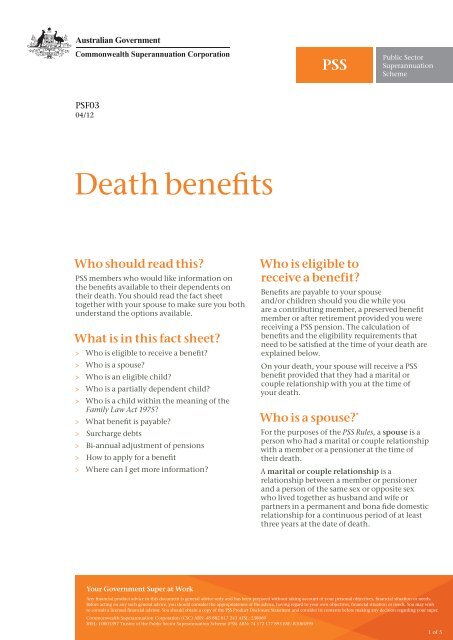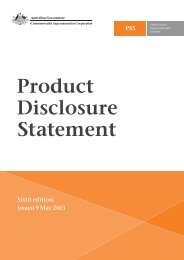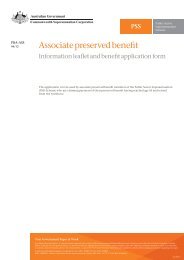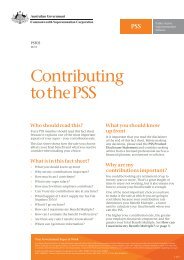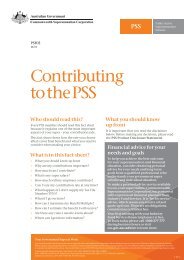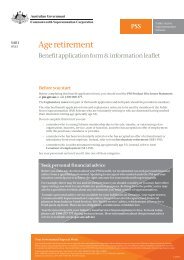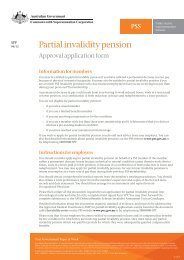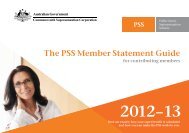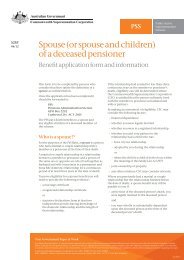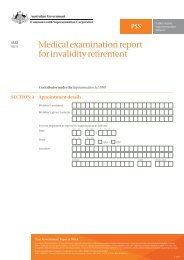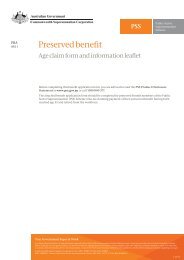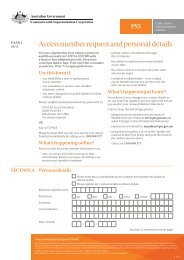Death benefits - PSS
Death benefits - PSS
Death benefits - PSS
Create successful ePaper yourself
Turn your PDF publications into a flip-book with our unique Google optimized e-Paper software.
PSF03<br />
04/12<br />
<strong>Death</strong> <strong>benefits</strong><br />
Who should read this?<br />
<strong>PSS</strong> members who would like information on<br />
the <strong>benefits</strong> available to their dependents on<br />
their death. You should read the fact sheet<br />
together with your spouse to make sure you both<br />
understand the options available.<br />
What is in this fact sheet?<br />
> > Who is eligible to receive a benefit?<br />
> > Who is a spouse?<br />
> > Who is an eligible child?<br />
> > Who is a partially dependent child?<br />
> > Who is a child within the meaning of the<br />
Family Law Act 1975?<br />
> > What benefit is payable?<br />
> > Surcharge debts<br />
> > Bi-annual adjustment of pensions<br />
> > How to apply for a benefit<br />
> > Where can I get more information?<br />
Who is eligible to<br />
receive a benefit?<br />
Benefits are payable to your spouse<br />
and/or children should you die while you<br />
are a contributing member, a preserved benefit<br />
member or after retirement provided you were<br />
receiving a <strong>PSS</strong> pension. The calculation of<br />
<strong>benefits</strong> and the eligibility requirements that<br />
need to be satisfied at the time of your death are<br />
explained below.<br />
On your death, your spouse will receive a <strong>PSS</strong><br />
benefit provided that they had a marital or<br />
couple relationship with you at the time of<br />
your death.<br />
Who is a spouse? *<br />
For the purposes of the <strong>PSS</strong> Rules, a spouse is a<br />
person who had a marital or couple relationship<br />
with a member or a pensioner at the time of<br />
their death.<br />
A marital or couple relationship is a<br />
relationship between a member or pensioner<br />
and a person of the same sex or opposite sex<br />
who lived together as husband and wife or<br />
partners in a permanent and bona fide domestic<br />
relationship for a continuous period of at least<br />
three years at the date of death.<br />
Your Government Super at Work<br />
Any financial product advice in this document is general advice only and has been prepared without taking account of your personal objectives, financial situation or needs.<br />
Before acting on any such general advice, you should consider the appropriateness of the advice, having regard to your own objectives, financial situation or needs. You may wish<br />
to consult a licensed financial advisor. You should obtain a copy of the <strong>PSS</strong> Product Disclosure Statement and consider its contents before making any decision regarding your super.<br />
Commonwealth Superannuation Corporation (CSC) ABN: 48 882 817 243 AFSL: 238069<br />
RSEL: L0001397 Trustee of the Public Sector Superannuation Scheme (<strong>PSS</strong>) ABN: 74 172 177 893 RSE: R1004595<br />
1 of 5
If the relationship had existed for less than<br />
three continuous years at the member or<br />
pensioner’s death, eligibility can still be<br />
determined where the Commonwealth<br />
Superannuation Corporation (CSC) is satisfied<br />
that the person ordinarily lived with the member<br />
or pensioner as husband and wife or partners.<br />
In making an assessment of eligibility,<br />
CSC may consider the following factors:<br />
> > financial dependence<br />
> > whether you were legally married<br />
> > whether you were in a registered relationship<br />
> > whether you and your partner in the<br />
relationship had a child who was:<br />
> > born of your relationship<br />
> > adopted by you during the relationship<br />
or<br />
> > where the child is a child of both of you<br />
within the meaning of the Family Law<br />
Act 1975<br />
> > joint ownership of property<br />
> > any other evidence CSC may consider relevant.<br />
Where a person previously had a marital or<br />
couple relationship but the relationship finished<br />
before the date of death, a spouse benefit may<br />
still be payable if:<br />
> > at the time of the deceased person’s death,<br />
the spouse was legally married to the<br />
deceased person<br />
and<br />
> > they were wholly or substantially dependent<br />
upon the deceased person at the time of the<br />
deceased person’s death.<br />
Who is a child? *<br />
For the purposes of the <strong>PSS</strong> Rules, a child in relation<br />
to a member who has died, is a child (including an<br />
adopted child, an ex-nuptial child, a step-child, a<br />
child within the meaning of the Family Law Act<br />
1975 or any other person whom CSC determines is<br />
to be treated as a child) of the member.<br />
The meaning of child in the Family Law Act 1975<br />
includes children:<br />
> > born to a woman as the result of an artificial<br />
conception procedure while that woman<br />
was married to, or was a de facto partner of,<br />
another person (whether of the same sex or<br />
opposite sex)<br />
and<br />
> > who are children of a person because of an<br />
order of a state or territory court made under a<br />
state or territory law prescribed for the purposes<br />
of section 60HB of the Family Law Act 1975,<br />
giving effect to a surrogacy agreement.<br />
Who is an eligible child? *<br />
An eligible child, is a child of the deceased member<br />
or pensioner (including an adopted child, an exnuptial<br />
child, a step-child, a child of the former<br />
member within the meaning of the Family Law Act<br />
1975 or any other person whom CSC determines is<br />
to be treated as a child of the member) who:<br />
> > has not reached age 16<br />
or<br />
> > is age 16 or more but less than age 25<br />
and<br />
> > is receiving full-time education at a school,<br />
college or university<br />
and<br />
> > is not ordinarily employed or self-employed<br />
and<br />
> > immediately before the death of the member:<br />
> > ordinarily lived with the member<br />
> > was, in the opinion of CSC, wholly or<br />
substantially dependent upon the member<br />
or<br />
> > where the child is born, after the death<br />
of the member, and would have, in the<br />
opinion of CSC, ordinarily lived with, or<br />
been wholly or substantially dependent<br />
on, the member if the child had been born<br />
before the death of the member.<br />
Who is a partially<br />
dependent child? *<br />
A partially dependent child is a child of the<br />
deceased member or pensioner (including an<br />
adopted child, an ex-nuptial child, a step-child,<br />
a child of the deceased member within the<br />
meaning of the Family Law Act 1975 or any other<br />
person whom CSC determines is to be treated as a<br />
child of the member) who:<br />
> > is not an eligible child<br />
and<br />
> > is aged less than 16, or is aged 16 or more<br />
but less than age 25<br />
and<br />
> > is receiving a full-time education at a<br />
school, college or university<br />
and<br />
> > is not ordinarily employed or selfemployed<br />
and<br />
> > in respect of whom, immediately before the<br />
death of the member:<br />
> > the deceased member was voluntarily<br />
making, or required by a court to make,<br />
regular maintenance payments<br />
or<br />
Your Government Super at Work<br />
2 of 5
in the opinion of CSC, the member would<br />
have been voluntarily making, or required<br />
by a court to make, such payments if the<br />
child had been born before the death of<br />
the member.<br />
* These descriptions paraphrase the definitions<br />
in the <strong>PSS</strong> Rules and the Family Law Act 1975.<br />
What benefit is payable?<br />
Higher dependent pension option<br />
If you retire on age or involuntary retirement<br />
grounds or claim your preserved benefit on age<br />
grounds you can elect to receive a lower pension<br />
in return for your spouse and/or children<br />
receiving a higher pension following your death.<br />
By electing to reduce your pension to 93% of<br />
the normal pension rate, your spouse and/or<br />
children will receive a higher pension following<br />
your death. Tables 1 and 2 show the various<br />
percentages payable.<br />
This option is not available if you retire on<br />
invalidity grounds or if you die while you are still<br />
a contributing or preserved benefit member of<br />
the <strong>PSS</strong>.<br />
Spouse of a contributing member or<br />
preserved benefit member<br />
If you die while you are a contributing or<br />
preserved benefit member, the pension payable<br />
to your spouse will be a percentage of the<br />
invalidity pension that would have been payable<br />
had you retired on invalidity grounds. Table 1<br />
shows the various percentages.<br />
Your spouse may choose to take their benefit as<br />
a pension, a lump sum or a combination of both<br />
(provided that at least 50% of the lump sum<br />
benefit is converted to pension).<br />
If you are a limited <strong>benefits</strong> member at the<br />
time of your death, no pension benefit is<br />
payable; the only benefit payable is a lump<br />
sum (see the Invalidity <strong>benefits</strong> fact sheet for<br />
more information).<br />
Spouse of a pensioner<br />
If you die while receiving a <strong>PSS</strong> pension, your<br />
spouse will be entitled to receive a pension that<br />
is a percentage of the pension being paid to you<br />
at the time of your death.<br />
The percentage payable will depend on whether<br />
you chose the higher dependent pension option<br />
at the time of your retirement. Table 1 shows<br />
the various pension percentages.<br />
If your marital or couple relationship started<br />
after you began receiving your pension and after<br />
you reached age 60, and the relationship existed<br />
for less than three continuous years at the date<br />
of death, your spouse will receive a proportion of<br />
the spouse’s pension that would normally have<br />
been payable. For example, if the relationship<br />
existed for one year, then your spouse would<br />
receive one-third of the full spouse’s pension.<br />
Apportionment of spouse’s benefit<br />
Where you are survived by more than one<br />
spouse, the benefit payable to each spouse<br />
may be apportioned having regard to their<br />
respective needs.<br />
Continuation of spouse’s entitlement<br />
Where a spouse who is receiving a pension<br />
remarries or starts a new relationship, the<br />
pension continues to be paid. However, they<br />
need to tell us as soon as possible so that our<br />
records remain correct.<br />
Rates of spouse’s pension<br />
Table 1 shows the percentage of your pension<br />
that would be payable to your spouse in the<br />
event of your death.<br />
Table 1: Calculation of spouse’s pension<br />
Number of<br />
Dependents<br />
Amount as<br />
percentage of<br />
former member’s<br />
standard rate<br />
pension<br />
Amount as<br />
percentage of<br />
former member’s<br />
reduced rate<br />
pension*<br />
Spouse only 67% 85 %<br />
Spouse and one<br />
child<br />
Spouse and two<br />
children<br />
Spouse and<br />
three or more<br />
children<br />
78 % 97 %<br />
89 % 108 %<br />
100 % 108 %<br />
*These percentage rates apply to a member who chose the high dependent<br />
pension option when they retired - refer to the Higher dependent<br />
pension option on page 3.<br />
Associate pensioner<br />
An associate pension, that is, a pension that<br />
is payable to the associate of a member or<br />
pensioner as the result of a family law split,<br />
does not pass to the associate’s spouse or children<br />
on the associate’s death.<br />
Payment of children’s pensions<br />
For the purposes of determining eligibility for<br />
<strong>PSS</strong> children’s <strong>benefits</strong>, a child includes a natural<br />
child, an adopted child, an ex-nuptial child, a<br />
step-child, or a child within the meaning of the<br />
Family Law Act 1975 who was either living with<br />
you or wholly or substantially dependent upon<br />
you at the time of death.<br />
Your Government Super at Work<br />
3 of 5
A child can also include your spouse’s child<br />
provided they were wholly or substantially<br />
dependent upon you at the time of death.<br />
Where a child is born after the date of death,<br />
the child will be entitled to children’s <strong>benefits</strong> if<br />
it is determined that the child would have lived<br />
with the member or been dependent on them.<br />
Children’s pensions are payable until the<br />
child reaches 16 years of age or until the age<br />
of 25 if the child is a full-time student and<br />
not ordinarily employed.<br />
If there is a spouse and eligible children, the<br />
amount of spouse’s pension payable is increased<br />
in respect of the eligible children.<br />
If there are eligible children, but no eligible<br />
spouse, then orphan’s <strong>benefits</strong> are payable.<br />
The rates of spouse’s pension (including<br />
children’s pensions) and orphan’s pension are<br />
shown in Tables 1 and 2 (the percentages in the<br />
third column of these tables only apply where<br />
a member chose the higher dependent pension<br />
option when they retired).<br />
Lump sum payable to orphans<br />
Where a contributing member dies and an<br />
orphan’s pension is payable, the pension is paid up<br />
to the age of 16 or up to age 25 while the orphan is<br />
a full-time student. This means that the pension<br />
may only be paid for a short period of time.<br />
A lump sum may, therefore, be paid to the orphan.<br />
This lump sum is the deceased member’s benefit<br />
accrual (including an amount in respect of the<br />
benefit that would have accrued to age 60), less<br />
an ‘estimation’ (based on factors provided by an<br />
actuary) of the amount of orphan’s pension that<br />
will be paid.<br />
This lump sum is paid to the orphan at the time<br />
the pension starts.<br />
Rates of orphan’s pension<br />
Table 2 shows the calculation of<br />
orphan’s pensions.<br />
Table 2: Calculation of orphan’s pension<br />
Number of<br />
orphans<br />
Amount as<br />
percentage of<br />
former member’s<br />
standard rate<br />
pension<br />
Amount as<br />
percentage of<br />
former member’s<br />
reduced rate<br />
pension*<br />
Payment of benefit where there are<br />
no dependents<br />
If you die while a contributing member and no<br />
spouse and/or children’s <strong>benefits</strong> are payable,<br />
a benefit consisting of your total <strong>PSS</strong> benefit<br />
accrual is payable to your estate.<br />
This benefit accrual would include an amount<br />
in respect of the benefit you would have accrued<br />
had you continued working to age 60 (provided<br />
your were not a limited <strong>benefits</strong> member—<br />
refer to the Invalidity <strong>benefits</strong> fact sheet for<br />
further information).<br />
If you die while a preserved benefit member<br />
and no spouse and/or children’s <strong>benefits</strong> are<br />
payable, a benefit comprising of your total<br />
preserved benefit at the time of death is payable<br />
to the estate.<br />
Minimum benefit payable<br />
—death of a pensioner<br />
The minimum benefit that must be paid in<br />
respect of a <strong>PSS</strong> member varies depending<br />
on whether the member retired on age or<br />
involuntary grounds or on invalidity grounds.<br />
If you retired on age or involuntary<br />
grounds, or were a preserved benefit member<br />
before your pension became payable, the<br />
minimum benefit is the total of your member<br />
contributions and fund earnings and the<br />
minimum employer benefit payable under the<br />
super guarantee legislation.<br />
If you retired on invalidity grounds, the<br />
minimum benefit is the benefit accrual up to<br />
the date of invalidity retirement (i.e. it does not<br />
include an amount in respect of the benefit that<br />
would have accrued had you continued working<br />
to age 60).<br />
Where no further pension is payable (i.e. you die<br />
and no spouse and/or children’s pensions are<br />
payable, or your spouse subsequently dies and<br />
no children’s benefit is payable), the minimum<br />
benefit payable is compared to the total <strong>benefits</strong><br />
paid out as pension and lump sum and any<br />
minimum benefit balance is paid to your estate.<br />
One 45% 51 %<br />
Two 80 % 92 %<br />
Three 90 % 108%<br />
Four or more 100 % 108 %<br />
*These percentage rates apply to a member who chose the high dependent<br />
pension option when they retired - refer to the Higher dependent<br />
pension option on page 3.<br />
Your Government Super at Work<br />
4 of 5
Surcharge debts<br />
If you die as a contributing member or a<br />
preserved benefit member any surcharge debt is<br />
deducted from outstanding <strong>benefits</strong> payable to<br />
your estate or spouse and/or children.<br />
Where death occurs after retirement there is no<br />
subsequent adjustment of <strong>PSS</strong> <strong>benefits</strong> but the<br />
Australian Taxation Office (ATO) may seek to<br />
recover, from your estate, any ‘trailing’ surcharge<br />
debt that had not been taken into account<br />
before the date of death. Generally such an<br />
amount relates only to the last financial year<br />
before retirement.<br />
Where can I get<br />
more information?<br />
EMAIL members@pss.gov.au<br />
PHONE 1300 000 377<br />
FAX 02 6272 9613<br />
MAIL<br />
WEB<br />
<strong>PSS</strong><br />
GPO Box 2252<br />
Canberra City ACT 2601<br />
www.pss.gov.au<br />
Bi-annual adjustment<br />
of pensions<br />
Pensions paid in respect of spouses and/or<br />
children are subject to bi-annual adjustments<br />
based on upwards movements in the Consumer<br />
Price Index.<br />
How to apply for a benefit<br />
<strong>Death</strong> while a contributing member or<br />
preserved benefit member<br />
Your spouse or legal representative should<br />
make an application using the form Benefit<br />
application—spouse (or spouse and children)<br />
of a deceased member. This is available at<br />
www.pss.gov.au or call 1300 000 377.<br />
The benefit application for orphans,<br />
Benefit application—orphan of a deceased<br />
member, is also available.<br />
<strong>Death</strong> following retirement<br />
Your spouse or legal representative should make<br />
an application using the form<br />
Benefit application—spouse of a pensioner.<br />
This is available at www.pss.gov.au or call<br />
1300 000 377.<br />
The benefit application for orphans,<br />
Benefit application—orphan of a pensioner,<br />
is also available.<br />
email<br />
phone<br />
tty<br />
post<br />
members@pss.gov.au<br />
web<br />
www.pss.gov.au<br />
1300 000 377<br />
overseas callers<br />
+61 2 6272 9622<br />
(02) 6272 9827<br />
fax<br />
(02) 6272 9613<br />
<strong>PSS</strong><br />
GPO Box 2252<br />
Canberra City ACT 2601<br />
5 of 5


